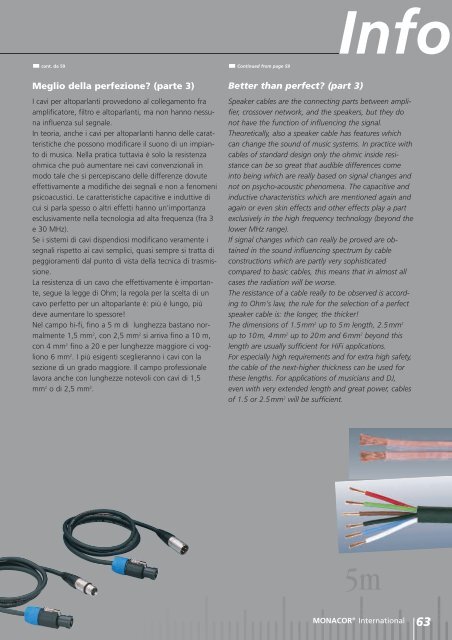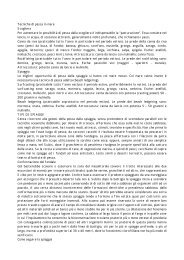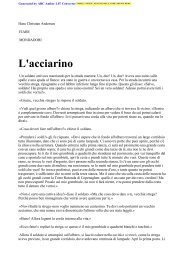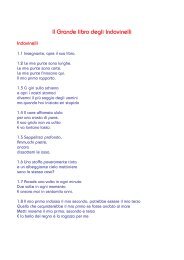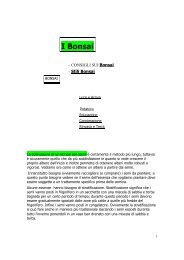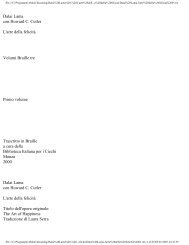You also want an ePaper? Increase the reach of your titles
YUMPU automatically turns print PDFs into web optimized ePapers that Google loves.
cont. da 59<br />
Meglio della perfezione? (parte 3)<br />
I cavi per altoparlanti provvedono al collegamento fra<br />
amplificatore, filtro e altoparlanti, ma non hanno nessuna<br />
influenza sul segnale.<br />
In teoria, anche i cavi per altoparlanti hanno delle caratteristiche<br />
che possono modificare il suono di un impianto<br />
di musica. Nella pratica tuttavia è solo la resistenza<br />
ohmica che può aumentare nei cavi convenzionali in<br />
modo tale che si percepiscano delle differenze dovute<br />
effettivamente a modifiche dei segnali e non a fenomeni<br />
psicoacustici. Le caratteristiche capacitive e induttive di<br />
cui si parla spesso o altri effetti hanno un'importanza<br />
esclusivamente nella tecnologia ad alta frequenza (fra 3<br />
e 30 MHz).<br />
Se i sistemi di cavi dispendiosi modificano veramente i<br />
segnali rispetto ai cavi semplici, quasi sempre si tratta di<br />
peggioramenti dal punto di vista della tecnica di trasmissione.<br />
La resistenza di un cavo che effettivamente è importante,<br />
segue la legge di Ohm; la regola per la scelta di un<br />
cavo perfetto per un altoparlante è: più è lungo, più<br />
deve aumentare lo spessore!<br />
Nel campo hi-fi, fino a 5 m di lunghezza bastano normalmente<br />
1,5 mm 2 , con 2,5 mm 2 si arriva fino a 10 m,<br />
con 4 mm 2 fino a 20 e per lunghezze maggiore ci vogliono<br />
6 mm 2 . I più esigenti sceglieranno i cavi con la<br />
sezione di un grado maggiore. Il campo professionale<br />
lavora anche con lunghezze notevoli con cavi di 1,5<br />
mm 2 o di 2,5 mm 2 .<br />
Continued from page 59<br />
Better than perfect? (part 3)<br />
Info<br />
Speaker cables are the connecting parts between amplifier,<br />
crossover network, and the speakers, but they do<br />
not have the function of influencing the signal.<br />
Theoretically, also a speaker cable has features which<br />
can change the sound of music systems. In practice with<br />
cables of standard design only the ohmic inside resistance<br />
can be so great that audible differences come<br />
into being which are really based on signal changes and<br />
not on psycho-acoustic phenomena. The capacitive and<br />
inductive characteristics which are mentioned again and<br />
again or even skin effects and other effects play a part<br />
exclusively in the high frequency technology (beyond the<br />
lower MHz range).<br />
If signal changes which can really be proved are obtained<br />
in the sound influencing spectrum by cable<br />
constructions which are partly very sophisticated<br />
compared to basic cables, this means that in almost all<br />
cases the radiation will be worse.<br />
The resistance of a cable really to be observed is according<br />
to Ohm's law, the rule for the selection of a perfect<br />
speaker cable is: the longer, the thicker!<br />
The dimensions of 1.5mm 2 up to 5m length, 2.5mm 2<br />
up to 10m, 4mm 2 up to 20m and 6mm 2 beyond this<br />
length are usually sufficient for HiFi applications.<br />
For especially high requirements and for extra high safety,<br />
the cable of the next-higher thickness can be used for<br />
these lengths. For applications of musicians and DJ,<br />
even with very extended length and great power, cables<br />
of 1.5 or 2.5mm 2 will be sufficient.<br />
MONACOR ® International 63


